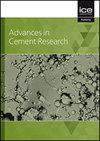Effect of gypsum on the hydration of fused cement clinker from basic oxygen furnace slag
IF 1.3
4区 工程技术
Q3 CONSTRUCTION & BUILDING TECHNOLOGY
引用次数: 0
Abstract
Fused cement clinker can be produced from molten basic oxygen furnace slag (BOFS) via a reductive thermochemical treatment. During the thermochemical treatment, oxidic iron is reduced to metallic iron and separated. The resulting low-iron slag has a chemical and mineralogical composition similar to ordinary Portland cement (OPC) clinker. In this study, the hydraulic reactivity of the fused clinker from BOFS (BOFS) with and without gypsum was investigated using isothermal calorimetry, differential scanning calorimetry (DSC), in-situ X-ray diffraction and powder X-ray diffraction (PXRD). Furthermore, a synthetic fused clinker without foreign ions and fused clinker produced by a mixture of both materials was studied. The hydraulic reaction of the fused clinker from BOFS was considerably slower than that of ordinary Portland cement. However, the reaction can be accelerated by adding gypsum as a sulfate carrier. Furthermore, the results showed an increased reaction rate with decreasing content of foreign ions such as Fe, P or Mn.石膏对碱性氧炉渣水泥熟料水化的影响
熔融碱性氧炉渣经还原性热化学处理可制成水泥熟料。在热化学处理过程中,氧化铁被还原为金属铁并被分离。由此产生的低铁渣具有类似于普通硅酸盐水泥(OPC)熟料的化学和矿物组成。采用等温量热法、差示扫描量热法(DSC)、原位x射线衍射法(原位x射线衍射法)和粉末x射线衍射法(PXRD)研究了含石膏和不含石膏的BOFS (BOFS)熔融熟料的水力反应性。研究了无外源离子的合成熔融熟料和两种材料混合生产的熔融熟料。BOFS熟料的水力反应明显慢于普通硅酸盐水泥。然而,加入石膏作为硫酸盐载体可以加速反应。结果表明,随着Fe、P、Mn等外源离子含量的降低,反应速率加快。
本文章由计算机程序翻译,如有差异,请以英文原文为准。
求助全文
约1分钟内获得全文
求助全文
来源期刊

Advances in Cement Research
工程技术-材料科学:综合
CiteScore
3.70
自引率
5.00%
发文量
56
审稿时长
3.2 months
期刊介绍:
Advances in Cement Research highlights the scientific ideas and innovations within the cutting-edge cement manufacture industry. It is a global journal with a scope encompassing cement manufacture and materials, properties and durability of cementitious materials and systems, hydration, interaction of cement with other materials, analysis and testing, special cements and applications.
 求助内容:
求助内容: 应助结果提醒方式:
应助结果提醒方式:


